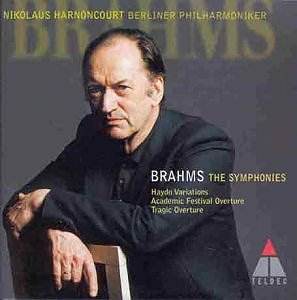When
these recordings were released to general acclaim I was not willing
to be impressed even though at least one close friend thereafter
expressed no further interest in new Brahms recordings since he
had the Harnoncourt recordings and they were "all he would
ever need." It was not until after I heard Harnoncourtís
Schubert set that I realised that I had probably missed something
really good, and set out to hear these. Iím glad I did.
The
playing by the Berliners is of course first-rate, and the recording
is everything we would expect from modern digital technology,
not surprising in a hall which has been extensively used for recordings
and is hence familiar to the engineers. The only difficulty I
noticed was an occasionally blaring trumpet in a cadential chord.
Why Harnoncourt or the engineer would allow that is not apparent.
With any other orchestra, we would blame it on the pressure of
a live recording, but we canít use that excuse with the Berliners
who would certainly know better.
Harnoncourt
mentions in the notes that the symphonies are generally played
too loud, and what he does is to be very sparing with his fortissimos,
using a more graded scale of dynamics than virtually any other
conductor. This heightens the drama and makes the symphonies more
transparent and listenable as well as more exciting.
Recordings
of the Brahms Symphonies by the Berlin Philharmonic Orchestra
with its recent music director Claudio Abbado have been well received
by some, however I have always found Abbadoís Brahms "smeary,"
that is lacking in incisiveness, rhythmic integrity, and drama,
all qualities this Harnoncourt set has in abundance. And if your
idea of perfect Brahms is slow and ponderous à la Otto
Klemperer, you probably wonít like Harnoncourt either.
The
first and third symphonies are magnificent classical structures
punctuated with the most brutal and explicit orchestral depictions
of bestial roars and shrieks, and these must be savage beyond
pity if the performance is to succeed. Apparently Brahms used
to howl and scream at the top of his lungs when improvising at
the piano so itís no wonder. Harnoncourt achieves the requisite
barbarity, except perhaps in the first movement of the Third where
Reinerís growls are a little more threatening. In the Third Symphony
Harnoncourt observes the first movement exposition repeat. He
would probably be arrested if he didnít play it ó however, I do
not approve, and Leopold Stokowski, Dimitri Mitropoulos, and Fritz
Reiner agree with me. But I must say Harnoncourt is able to make
more sense out of it than I have ever heard before.
It
is in the Second Symphony that we clearly see how Brahmsí sense
of rhythm is vastly better than Beethoven. A Beethoven symphony
is constantly struggling to get up off the floor; a Brahms symphony
barely touches the floor. Trying to dance to Beethoven will get
you a sprained ankle and maybe a twisted knee, whereas trying
not to dance to Brahms can cause one to destroy a chair.
Brahms and Mendelssohn are alike in this, although Brahms was
much more earthy than Mendelssohn who was more gentlemanly and
sophisticated. Mendelssohnís music never screams, but Brahmsí
does all the time. Also Mendelssohn and Brahms are both capable
of geniality, even frivolity, in close proximity to drama and
tragedy.
A
recording of the Fourth Symphony stands or falls upon the flute
solo in the last movement, where the flute stands in for all the
pleading, hopeful, gentleness and innocence in the world. Steinbergís
recording fails at this point, but Charles Munch, and even Maurice
Abravanel and Antal Dorati ride through well with their respective
flutists. The brutality of the following heroics blows all this
away but leaves us with hope that somehow kindness has triumphed.
Yet, even though the war is over, we are not completely sure who
won, a feeling that the world was to become all too familiar with
in the ensuing decades. No wonder many people prefer Beethoven
where the good guys always win.
The
notes are especially interesting, being a lengthy interview of
Harnoncourt by Walter Dobner. The two discuss Brahmsí long agonising
over producing his first symphony and then discuss influences,
Harnoncourt mentioning that he feels the music of Schumann was
a particularly strong influence on Brahmsí Symphonic style. Recognising
that this brief essay was not intended to be an exhaustive study
of the subject, still their attempt to list the major influences
on Brahms leaves me bewildered at their overlooking the most obvious
influence of all: Mendelssohn. Many bars of the Fingalís Cave
Overture appear unmodified in the Tragic Overture (along
with a deep drink of Götterdämmerung of course),
the skipping violins from Midsummer Nightís Dream music
are prominent in the Academic Festival Overture, and the
Big Tune from Brahmsí First Symphony is almost identical
to the Big Tune from Mendelssohnís Scottish Symphony, to
say nothing about the structure of the movements in which they
occur. I think it is obvious that it was Brahmsí becoming aware
of Mendelssohnís Scottish Symphony that finally broke his
symphonic deadlock by showing him a way out from the need to imitate
Beethoven; how to be beautiful, strong, and profound without being
tedious.
Also,
they discuss the Second Symphony and its relatively geniality
in comparison to the other three numbered symphonies, but neglect
to compare it with the Serenades, where it fits right in
as #3. Could the Serenades have been influenced by the
Mendelssohn String Symphonies? I think Dobner and Harnoncourt
need to have their talk all over again.
My
previous favourite set of the Brahms Symphonies is listed in the
comparisons above, but I think some changes will be made. Itíll
take a little more listening to be sure, and Iím looking forward
to it.
Paul
Shoemaker


![]() Berlin Philharmonic Orchestra/Nikolaus
Harnoncourt
Berlin Philharmonic Orchestra/Nikolaus
Harnoncourt ![]() TELDEC 0630-13136-2
[66.05+70.13+77.36]
TELDEC 0630-13136-2
[66.05+70.13+77.36]